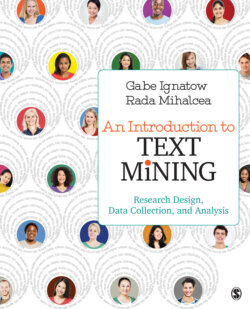Читать книгу An Introduction to Text Mining - Gabe Ignatow - Страница 7
На сайте Литреса книга снята с продажи.
Preface
ОглавлениеStudents are accustomed to participating in all sorts of online communities. While interacting on platforms such as Facebook, Twitter, Snapchat, and Instagram as well as on blogs, forums, and many other apps and sites, some students taking courses in the social sciences and computer science want to take things a step further and perform their own research on the social interactions that occur in these communities. We have written this book for those students, including especially undergraduate and graduate students in anthropology, communications, computer science, education, linguistics, marketing, political science, psychology, and sociology courses who want to do research using online tools and data sets. Whether they are writing a term paper or honors thesis, or working on an independent research project or a project with a faculty adviser, students who want to use text mining tools for social research need a place to start.
Online communities offer no end of interesting linguistic and social material to study, from emojis and abbreviations to forms of address, themes, metaphors, and all sorts of interpersonal conversational dynamics. The volume of data available for research, and the many research tools available to students, are simply overwhelming. An Introduction to Text Mining is here to help. The book is organized to guide students through major ethical, philosophical, and logical issues that should be considered in the earliest stages of a research project (see Part I) and then to survey the landscape of text mining and text analysis tools and methodologies that have been developed across the social sciences and computational linguistics. Appendices A through G on data and software resources are a key to the book, and readers should consider reviewing these early and returning to them often as they work their way through the early chapters and begin to design their own research projects (see Chapter 5).
If you think of your text mining research project as a house, then the chapters in Part I are instructions for building the foundation. Just as a house with a flaw in its foundation will not last long, a research project with a shaky logical foundation or questionable ethics may look good at the start, but it is inevitable that at some point its flaws will be exposed. Chapter 5 on research design provides architectural instruction for building the framework of your house. Designing a research project that can address, and perhaps conclusively answer, a research question or questions is a challenging task, and it is useful to know the kinds of research designs that have a track record of success in research using text mining tools and methodologies. Parts III through V survey text mining and analysis methodologies, the equivalent of proven house-building methods. Appendix A provides a partial survey of online sources of textual data, which is the raw material of your research project. Appendices B through G provide, as it were, a survey of the practical tools that are available for house construction, from hand tools to heavy-duty machinery. While setting the foundation, designing the house, and choosing a construction method, it is a good idea to be aware of the types of practical tools that are available and within budget so that your project can reach a successful conclusion. Appendices H and I, as well as the Glossary, provide handy summaries of web resources, statistical tools, and key terms.
Additional resources for instructors using An Introduction to Text Mining are also provided. Editable, chapter-specific Microsoft¯ PowerPoint¯ slides, as well as assignments and activities created by the authors, are available for download at: http:/study.sagepub.com/introtextmining.
